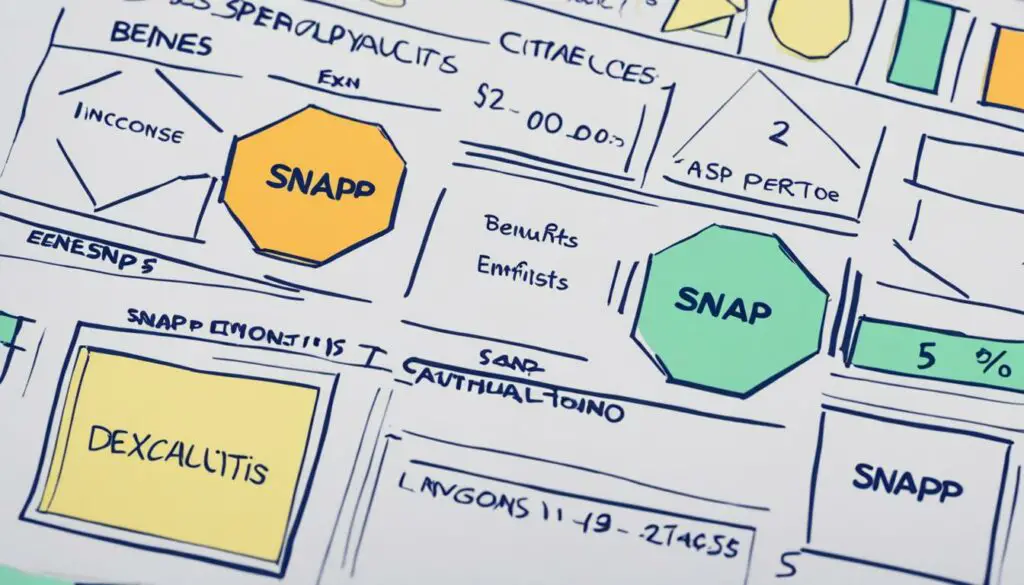Originally posted on December 20, 2023 @ 4:30 pm
Welcome to our article on food stamps and taxes! In the United States, the Supplemental Nutrition Assistance Program (SNAP), commonly known as food stamps, plays a crucial role in assisting low-income individuals and families in accessing nutritious food. But how exactly do food stamps affect your taxes? Let’s delve into the tax implications of food stamps and discover if they can have an impact on your tax refunds.
Table of Contents
Key Takeaways:
- Food stamps, or SNAP benefits, can have an impact on your taxes in the United States.
- Understanding the tax implications of food stamps is essential for both taxpayers and program participants.
- Eligibility and benefit calculations for SNAP are based on income and household size.
- Increased SNAP spending can stimulate the economy, leading to job creation and GDP growth.
- State policies and variations in SNAP and sales tax policies can affect the overall impact of food stamps on taxes.
Eligibility and Benefits of SNAP
To qualify for SNAP benefits, individuals and families must meet specific income guidelines. The size of the benefit is determined by income and certain expenses. Eligibility and benefit calculation rules are in effect for fiscal year 2024, which began in October 2023. Income includes cash income from all sources, while assets must fall below certain limits. SNAP benefits provide additional resources for buying food to low-income households.
Finding Out If You Qualify for SNAP

If you believe you may qualify for SNAP benefits, you can contact your local human services office or state human services agency to begin the application process. These agencies will assess your eligibility based on income, expenses, and other factors. If your circumstances have changed recently, such as a loss of income or an increase in certain expenses, you may be eligible for increased benefits.
Applying for SNAP benefits involves a straightforward process that starts with gathering the necessary information and contacting the appropriate agency:
- Contact your local human services office or state human services agency to inquire about SNAP benefits.
- Request an application form, which can usually be obtained online or in person during office hours.
- Complete the application form accurately, providing all the required details about your household, income, and expenses.
- Gather the necessary supporting documents, such as proof of identification, income verification, and expenses receipts.
- Schedule an appointment or submit your application and documents as required by your local human services office or state human services agency.
During the application process, it’s crucial to communicate any changes in your circumstances that may affect your eligibility or entitlement to benefits. This includes updates to income, expenses, household composition, or contact information. Keeping your information up-to-date ensures that you receive accurate assistance and potentially increased benefits.
| Documents Required for SNAP Application | Proof of Eligibility |
|---|---|
| Proof of identification (e.g., driver’s license, birth certificate) | Identity verification |
| Proof of income (e.g., pay stubs, tax return documents) | Income verification |
| Proof of expenses (e.g., rent/mortgage, utility bills) | Expense deduction calculation |
| Proof of citizenship or immigration status | Eligibility determination |
| Proof of Social Security numbers for all household members | Household composition verification |
Local Human Services Office and State Human Services Agency
Your local human services office and state human services agency play a crucial role in administering SNAP benefits and determining your eligibility. These agencies have knowledgeable staff members who can guide you through the application process, answer your questions, and provide updated information about SNAP benefits.
Contacting your local human services office or state human services agency allows you to:
- Obtain accurate information about SNAP eligibility and benefits.
- Receive assistance in completing the application form and gathering the necessary documentation.
- Submit your application and supporting documents for review.
- Stay informed about updates, changes, and additional resources related to SNAP benefits.
“Contact your local human services office or state human services agency to find out if you qualify for SNAP benefits. Their knowledgeable staff members can guide you through the application process and provide important updates regarding eligibility and benefits.”
By reaching out to your local human services office or state human services agency, you can ensure that you receive accurate guidance and the most up-to-date information about SNAP benefits. Remember to provide complete and honest information during the application process, and don’t hesitate to update your circumstances if necessary. Increased benefits may be available if you experience changes such as a loss of income or increased expenses.
Determining SNAP Eligibility

Eligibility for SNAP benefits is determined by three key tests: gross monthly income, net income, and assets. To qualify, your gross monthly income must generally be at or below 130 percent of the poverty line for your household size. After deductions, your net income must also be at or below the poverty line. Additionally, your assets must fall below specific limits, although there are exceptions for households with members aged 60 or older or with disabilities. It’s important to note that income sources, asset classification, and eligibility exemptions can vary based on state rules.
To determine if you meet the eligibility criteria, you’ll need to consider your household’s gross and net income as well as your assets. Here’s a breakdown of each test:
- Gross Monthly Income: This includes all income from various sources, such as wages, self-employment earnings, Social Security benefits, and pensions. It’s important to calculate your gross monthly income accurately to determine eligibility.
- Net Income: Net income is your gross monthly income minus certain deductions, such as shelter expenses, child support payments, and medical expenses for elderly or disabled individuals. Deductions can help lower your net income and increase your chances of meeting eligibility requirements.
- Assets: Assets refer to property or possessions that have a monetary value. These can include cash, bank accounts, vehicles (excluding the one used for transportation), real estate other than your primary residence, and certain valuable personal property. The total value of your assets must fall below specific limits to qualify for SNAP benefits, with some exceptions for households with older adults or disabled individuals.
It’s important to understand the specific rules and guidelines set by your state regarding SNAP eligibility tests and exemptions. Each state may have its own criteria and requirements. Considering these factors will help determine your eligibility for SNAP benefits and ensure you receive the support you need.
For a visual representation of SNAP eligibility tests and income guidelines, refer to the table below:
| SNAP Eligibility Tests | Income Guidelines |
|---|---|
| Gross Monthly Income | At or below 130% of the poverty line for household size |
| Net Income | At or below the poverty line after deductions |
| Assets | Fall below specific limits, with exceptions for households with older adults or disabled individuals |
Calculating SNAP Benefits

SNAP benefits, also known as food stamps, are calculated based on a household’s net income and size. The amount of benefits received is determined using the Thrifty Food Plan (TFP), which estimates the cost of a nutritionally adequate diet for low-income households.
The calculation takes into account the expectation that families will spend approximately 30 percent of their net income on food. Families with no net income will receive the maximum benefit tied to the TFP, ensuring they have the resources necessary to meet their food needs. On the other hand, families with some net income will have their benefits reduced based on their expected contribution towards food expenses.
Let’s take a closer look at how SNAP benefits are calculated:
- Step 1: Determining Net Income
- Step 2: Estimating the Thrifty Food Plan (TFP)
- Step 3: Calculating Maximum Benefit
- Step 4: Determining Household Benefit
Net income is the total income after deducting certain allowable expenses. These expenses may include shelter costs, dependent care expenses, and medical expenses for elderly or disabled household members. The remaining income is the net income used in the benefit calculation.
The Thrifty Food Plan (TFP) is developed by the U.S. Department of Agriculture (USDA) and is used as a benchmark to determine the cost of a nutritionally adequate diet. The TFP accounts for factors such as household size and composition, age, and gender of the members when estimating food budgets.
The maximum benefit is the amount tied to the Thrifty Food Plan (TFP) and varies based on the household size. Larger households have higher maximum benefits to accommodate their food needs.
The household benefit is calculated by subtracting the expected contribution towards food expenses from the maximum benefit. The expected contribution is calculated by multiplying the household’s net income by 0.3 (30 percent).
By following this calculation process, SNAP benefits provide crucial assistance to low-income families by supplementing their food budget and helping them afford a nutritionally adequate diet.
Benefit Calculation Example:
Let’s consider an example:
| Household Size | Net Income | Expected Contribution | Maximum Benefit | Household Benefit |
|---|---|---|---|---|
| 3 | $1,200 | $360 | $600 | $240 |
“In this example, a household of three with a net income of $1,200 would be expected to contribute $360 towards their food expenses. The maximum benefit for a household of this size is $600. Therefore, their SNAP benefit would be $240, calculated by subtracting the expected contribution from the maximum benefit.”
It’s important to note that the SNAP benefit calculation may vary based on factors such as income changes, household composition, and updates to the Thrifty Food Plan. Eligible individuals and families should consult with their local SNAP office or state human services agency for the most accurate benefit calculation based on their specific circumstances.
Now that we understand the calculation process, let’s explore the broader economic impact of SNAP benefits in the next section.
Economic Impact of SNAP Benefits

SNAP benefits play a vital role in supporting the economy, particularly during times of economic downturn. By providing increased spending power to low-income households, SNAP acts as an automatic stabilizer, stimulating economic activity and supporting various sectors.
Research suggests that for every $1 billion in new SNAP benefits, there is a multiplier effect on the economy. This multiplier effect results in a positive impact on key economic indicators such as Gross Domestic Product (GDP), employment, and income.
The injection of SNAP benefits into the economy leads to increased consumer spending, which in turn creates a higher demand for goods and services. This increased demand generates economic activity and has a ripple effect throughout the economy, leading to job creation and income effects.
Impact on Gross Domestic Product (GDP)
GDP is a measure of the total value of goods and services produced within a country’s borders. Increased spending resulting from SNAP benefits contributes to economic growth and boosts GDP. The additional purchasing power enables low-income households to engage in more economic transactions, thereby increasing the production and sale of goods and services.
Benefit to Agriculture Industries
Agriculture industries also benefit from SNAP benefits. The extra funds provided to low-income households allow them to buy more food, which supports increased demand for agricultural products. This, in turn, has a positive impact on farmers, food producers, and other actors within the agriculture sector, providing them with additional income and stability.
Job Creation
The economic stimulus provided by SNAP benefits leads to job creation. As consumer spending increases, businesses experience higher demand for their products and services. To meet this demand, companies may need to hire additional workers, leading to increased employment opportunities.
SNAP benefits help stimulate economic activity and contribute to the overall well-being of the economy by supporting low-income households, boosting GDP, benefiting agriculture industries, and promoting job creation.
The impact of SNAP benefits goes beyond providing assistance to individuals and families in need. It plays a crucial role in maintaining economic stability, especially during challenging economic times. By supporting the economy and various industries, SNAP benefits have a positive and far-reaching impact on the overall economic wellbeing of the nation.
Food Purchases by SNAP and Non-SNAP Households

A study comparing food purchases by SNAP and non-SNAP households revealed interesting insights into their spending patterns. Despite their different income levels, both groups allocated a significant portion of their food budget to essential items such as meat, fruits, vegetables, milk, and bread. This indicates the shared importance of these basic food items among SNAP and non-SNAP households alike.
The study reignited the ongoing debate surrounding eligible foods for SNAP benefits and the potential for introducing restrictions. Considering the similarities in spending patterns, policymakers and stakeholders are faced with the challenge of striking a balance between allowing for individual food preferences and promoting healthy eating choices.
Another factor to consider is the sales tax exemptions that vary by state. SNAP purchases are generally not subject to sales tax, which can result in differences in the taxation of certain food items between SNAP and non-SNAP households. This variation in tax treatment adds complexity to the overall discussion of food purchases and taxation.
| Food Category | Percentage of Total Food Budget (SNAP Households) | Percentage of Total Food Budget (Non-SNAP Households) |
|---|---|---|
| Meat | 28% | 26% |
| Fruits | 18% | 21% |
| Vegetables | 20% | 18% |
| Milk | 12% | 14% |
| Bread | 10% | 12% |
Complexity of Determining Healthy Food

Defining healthy food is a complex task, and implementing restrictions on SNAP benefits based on health criteria poses challenges. The USDA and various states have grappled with determining what constitutes healthy food for the purpose of SNAP eligibility and sales tax exemptions.
Factors such as calorie content, nutrients, and ingredients all come into play when considering the healthiness of a particular item.
Balancing public health concerns with the complexity of administering restrictions is a key consideration. It is important to establish criteria for healthy food that are both effective in promoting proper nutrition and feasible to implement within the SNAP program.
The Challenges in Categorizing Food
The process of categorizing food as healthy or unhealthy is not straightforward. Different foods can have varying nutritional profiles, making it difficult to create a definitive list of healthy options.
Furthermore, individual dietary needs and preferences vary, which adds another layer of complexity in determining what foods should be considered healthy for SNAP recipients.
The Role of the USDA
The United States Department of Agriculture (USDA) plays a key role in establishing guidelines for healthy food. They provide recommendations on the types and quantities of food that individuals should consume for optimal health.
The USDA’s guidelines serve as a foundation for determining what foods should be eligible for SNAP benefits. However, translating these guidelines into clear criteria for SNAP can be challenging.
Differing State Policies
Another complexity arises from the fact that different states have their own policies regarding SNAP eligibility and sales tax exemptions. This creates inconsistencies and variations in the definition of healthy food across the country.
While some states may have stringent criteria for eligible food items, others may have more relaxed standards. This can lead to disparities in the types of food that SNAP recipients can purchase.
Considerations for Balancing Health and Accessibility
When establishing criteria for healthy food within SNAP, it is crucial to strike a balance between promoting nutritious options and ensuring accessibility for all participants. Restricting food choices too strictly may limit access to essential items for vulnerable populations.
The challenge lies in finding the right balance that addresses public health concerns while considering the diverse needs and circumstances of SNAP beneficiaries.
“The process of categorizing food as healthy or unhealthy is not straightforward.”
A comprehensive approach involves ongoing collaboration between policymakers, nutrition experts, and the public to refine the criteria for healthy food within SNAP. This ensures that decisions are evidence-based and take into account the ever-evolving understanding of nutrition and dietary needs.
Impact of SNAP Spending on GDP

Increased SNAP spending plays a crucial role in driving economic growth, especially during periods of economic slowdowns. The multiplier effect of SNAP benefits has far-reaching effects on various industries, leading to a significant boost in Gross Domestic Product (GDP), employment rates, and income levels.
Multiple studies have demonstrated that for every $1 billion in new SNAP benefits, there is a notable positive impact on the overall economy. This translates into job creation, increased consumer spending, and a stimulated economy. The employment effects of SNAP spending can be observed across sectors, providing a lifeline for communities and supporting the well-being of families.
The multiplier effect of SNAP spending extends beyond immediate economic impacts, creating a ripple effect that benefits numerous industries and fosters overall economic stability.
This increased expenditure on goods and services generates additional income for businesses, enabling them to expand operations and hire more employees. Consequently, this increase in employment opportunities further contributes to rising income levels for individuals and households.
Moreover, the multiplier effect of SNAP benefits helps to stabilize the economy during economic downturns. The injection of funds into the hands of low-income households provides them with increased spending power, which in turn stimulates demand and supports local businesses.
By promoting increased consumption and supporting various industries, SNAP spending acts as an economic stimulus, fostering resilience and aiding in economic recovery. The positive impact on GDP, employment, and income effects showcases the effectiveness of SNAP benefits as both a social support program and an economic driver.
| Benefits of SNAP Spending on GDP | Negative Effects of Reduced SNAP Spending on GDP |
|---|---|
|
|
The positive impact of SNAP spending on GDP highlights the importance of the program in providing not only essential support to low-income individuals and families but also in bolstering the overall economy.
Costs and Benefits of Restricting SNAP Purchases
Implementing restrictions on SNAP purchases to promote healthier choices comes with several considerations. While the intention behind these restrictions is to improve the health outcomes of program participants, it’s important to assess the costs and benefits associated with these measures.
The administrative complexity involved in determining which foods are eligible for purchase under SNAP can create challenges. The program needs to establish clear criteria for defining what constitutes healthy food and ensure consistent enforcement across different grocery retailers. This adds a layer of complexity to the existing administrative processes.
Furthermore, imposing restrictions on SNAP purchases also has sales tax implications. Since SNAP purchases are exempt from sales tax, the introduction of restrictions could result in variations in taxation across different food items. Identifying and categorizing eligible foods that align with health criteria while considering sales tax exemptions can complicate the implementation process.
Therefore, it is crucial to carefully balance the costs and benefits of restricting SNAP purchases. While promoting healthier choices is a worthwhile goal, it is essential to consider the impact on both taxpayers and program participants. By analyzing the administrative complexity, determining eligible foods, and understanding the sales tax implications, policymakers can make informed decisions that effectively address public health concerns while ensuring program efficiency.
State Variations in SNAP and Sales Tax Policies
SNAP, also known as the Supplemental Nutrition Assistance Program, and sales tax policies can vary significantly from state to state in the United States. Each state has the flexibility to implement additional restrictions or exemptions based on their specific needs and priorities. Understanding the policies in your state is crucial when considering the impact of SNAP benefits on taxes and sales tax implications.
Streamlined States vs. Non-Streamlined States
When it comes to SNAP and sales tax policies, states are often categorized as either streamlined or non-streamlined. Streamlined states typically have common definitions for eligible foods and taxable items, making it easier to navigate the system. On the other hand, non-streamlined states may have unique criteria for determining eligibility and restrictions on eligible items.
To illustrate the differences and provide a clearer understanding, let’s take a look at a simplified comparison:
| Streamlined States | Non-Streamlined States |
|---|---|
| Consistent definitions for eligible foods | Varying definitions for eligible foods |
| Common guidelines for taxable items | State-specific guidelines for taxable items |
| Easier navigation and understanding | Potentially more complex rules and regulations |
Exemptions and Limitations
In addition to the variations between streamlined and non-streamlined states, there are exemptions and limitations that can further differ from state to state. These exemptions and limitations can impact the types of items that are eligible for SNAP benefits and whether they are subject to sales tax.
Here are some examples of exemptions and limitations:
- Some states may exempt certain staple foods, such as bread or milk, from sales tax.
- Other states may have limitations on the purchase of certain items, such as prepared foods or non-food items.
- States can also impose restrictions on the use of SNAP benefits for specific items, such as the purchase of alcohol or tobacco products.
It is important to familiarize yourself with the exemptions and limitations in your state to ensure compliance with the regulations and make informed decisions about SNAP benefit usage.
Understanding the specific policies and variations in your state is crucial when it comes to navigating SNAP and sales tax regulations. By staying informed and aware of the exemptions, limitations, and streamlined status of your state, you can make the most of SNAP benefits while ensuring compliance with tax regulations.
Conclusion
In conclusion, food stamps, also known as SNAP benefits, can have significant implications for taxes in the United States. Eligibility and benefit calculations are primarily based on income and household size. While food stamps provide much-needed assistance to low-income households, they also impact taxpayers through various means.
One notable effect of increased SNAP spending is its positive impact on the economy. The injection of funds into the system acts as an economic stimulus, leading to job creation, GDP growth, and additional income for the agriculture industries. Research shows that SNAP benefits have a multiplier effect, resulting in a substantial boost to the overall economy.
However, the determination of eligible foods and the restrictions surrounding SNAP benefits present unique challenges. Defining what constitutes healthy food and implementing restrictions based on health criteria is a complex task. Administratively, this adds an additional layer of complexity and costs to the program, which needs to be carefully balanced to ensure the effectiveness of the program while minimizing the burden on taxpayers.
Furthermore, it is important to note that state policies regarding SNAP and sales tax can vary significantly. Each state may have its own set of policies and exemptions, making it crucial to understand the specific regulations in your state. Being aware of the implications of food stamps on taxes is essential for both taxpayers and program participants alike.
FAQ
Do food stamps affect your taxes?
Yes, food stamps, also known as SNAP benefits, can have an impact on your taxes.
What are the tax implications of having food stamps?
Food stamps are not counted as taxable income, so they do not affect your taxes directly. However, they may affect other aspects of your tax return, such as your eligibility for certain tax credits or deductions.
Can you get a tax refund if you receive food stamps?
It is possible to receive a tax refund even if you receive food stamps. The amount of your refund will depend on various factors, including your income, deductions, and tax credits.
How do food stamps impact your taxable income?
Food stamps are not considered taxable income, so they do not affect your taxable income.
What are the IRS rules on food stamps and taxes?
The IRS does not consider food stamps as taxable income, but they may impact your eligibility for certain tax credits or deductions. It’s important to consult with a tax professional or review IRS guidelines for specific information related to your situation.
What are the government assistance programs and tax obligations?
Government assistance programs, such as SNAP benefits, can impact your tax obligations. While the benefits themselves are generally not taxable, they may affect your eligibility for certain tax credits and deductions.
How do SNAP benefits impact your tax liability?
SNAP benefits do not directly impact your tax liability. However, they may affect your eligibility for certain tax credits or deductions, which can ultimately impact your overall tax liability.
Source Links
- https://www.cbpp.org/sites/default/files/11-18-08fa.pdf
- https://www.ers.usda.gov/amber-waves/2019/july/quantifying-the-impact-of-snap-benefits-on-the-u-s-economy-and-jobs/
- https://www.wolterskluwer.com/en/expert-insights/food-stamps-and-sales-tax-exemptions
See also:
Leave a Reply